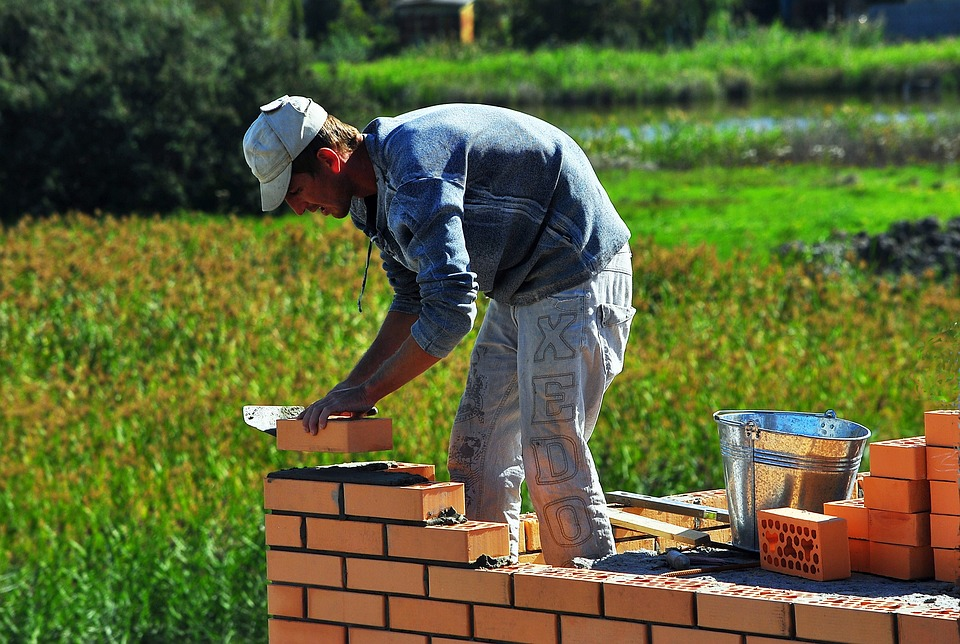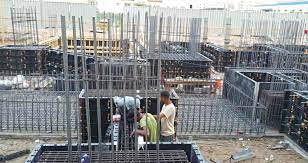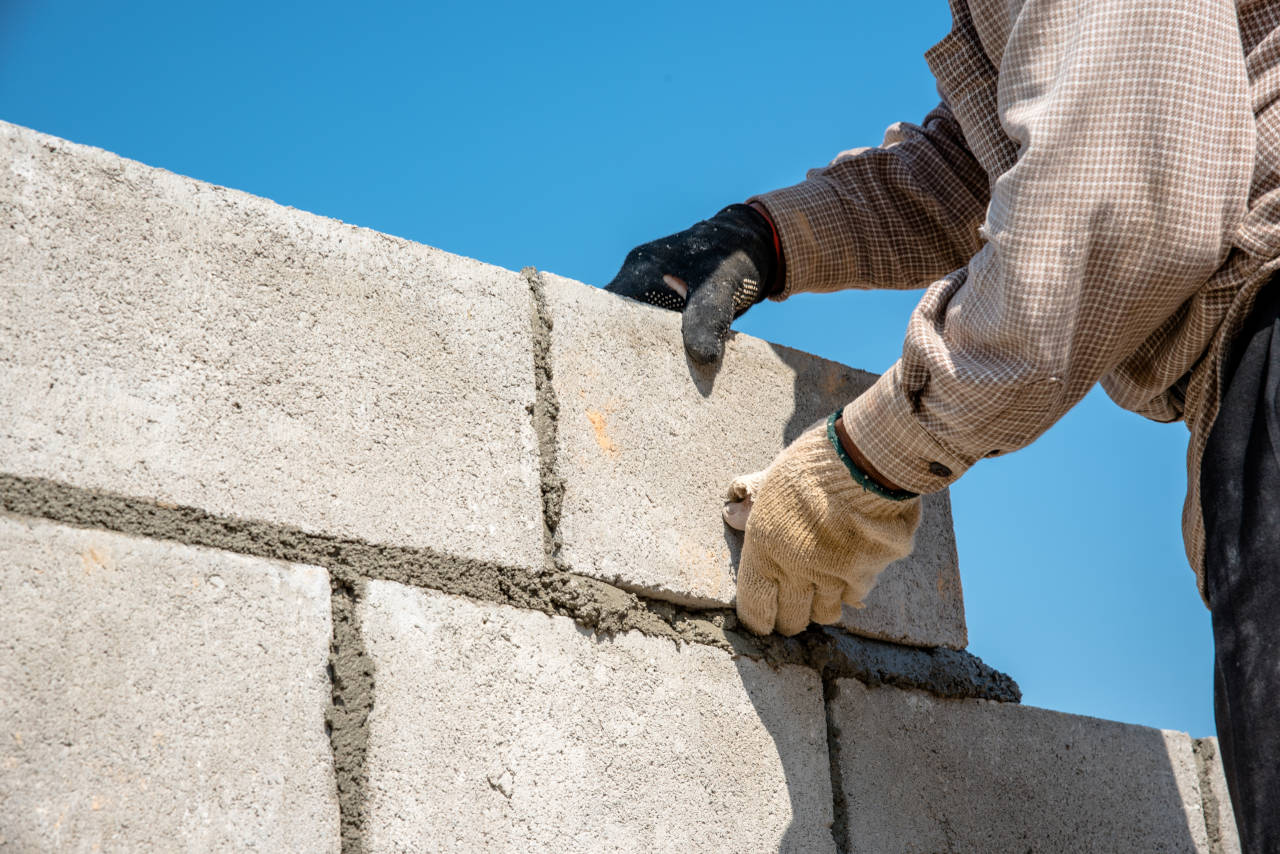Assistant Mason (6 month course)
Assistant Mason click here
Brief Job Description
This job role is responsible for assisting in brick/block work including fixing doors and windows and
plastering works, assisting in tiling, stone laying and concrete masonry works , brick soling and (plain
cement concrete) PCC flooring including use of hand and power tools and erection and dismantle of
temporary scaffold of 3.6m height.
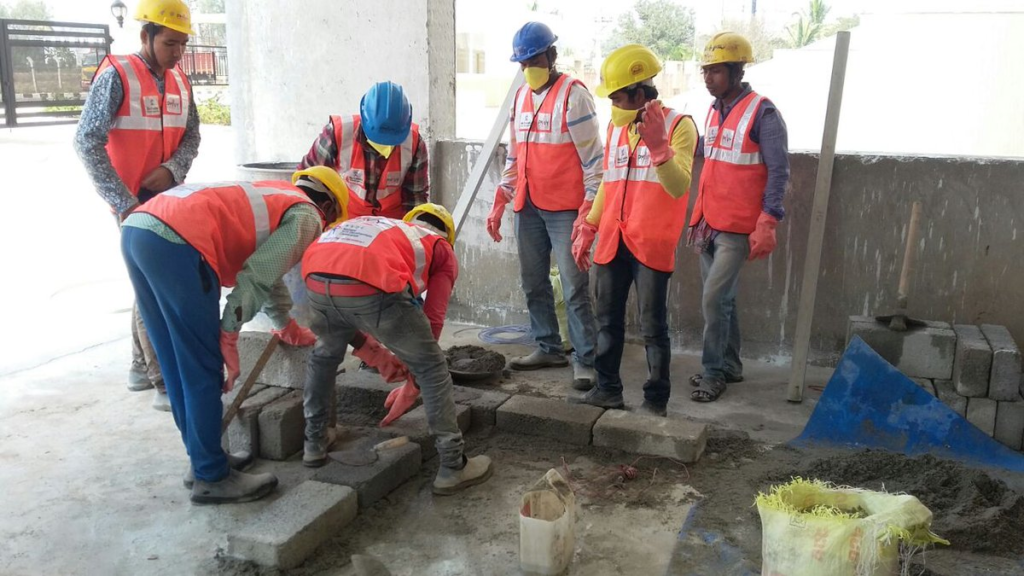
Personal Attributes
The individual is expected to be physically fit and should be able to work across various locations in
extreme weather/site conditions. The person must be able to perform efficiently within a team, handle the
various masonry tools and materials and work responsibly.
Erect and dismantle temporary scaffold up to 3.6 meter height
Description
This unit describes the skills and knowledge required to erect and dismantle 3.6 meter temporary scaffold
Scope
The scope covers the following :
Erect and dismantle temporary scaffold up to 3.6 meter height
Elements and Performance Criteria
• Erect and dismantle temporary scaffold up to 3.6 meter height
To be competent, the user/individual on the job must be able to:
PC1. level area where scaffold need to be erected and check for ground compactness if required
PC2. shift and stack required materials, components, tools and tackles at the instructed location
PC3. wear and use required safety gadgets and follow trade safety
PC4. place base plates and sole boards on the ground as per markings and instructions
PC5. use proper components and follow standard procedure for erecting temporary scaffold up to 3.6 m
PC6. check verticality of scaffold at first level of erection and correct (if required) before moving to
the next level
PC7. check for rigidity, stability and support of erected scaffold
PC8. fix walk-boards, guard rails, toe-boards and other components on working platform
PC9. follow standard procedure for dismantling of 3.6 m temporary scaffold
PC10. remove guard rails, toe boards, walk boards and other components sequentially
PC11. clean and stack all components properly after dismantling
PC12. maintain tidiness at work location
Knowledge and Understanding (KU)
The individual on the job needs to know and understand:
KU1. standard procedure for scaffolding works
KU2. safety rules and regulations for handling and storing scaffolding tools, materials and
components
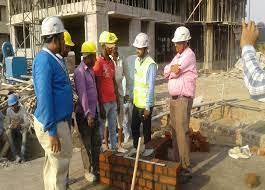
KU3. personal protection including use of safety gears and equipment
KU4. safe working methods and movements while performing relevant tasks
KU5. request procedure for tools & materials
KU6. housekeeping & other administrative rules
KU7. use of different types of scaffolds (cup-lock , frame scaffold)
KU8. use of tools and tackles in scaffolding works
KU9. identification and use of different components
KU10. use of tools for measurements and marking
KU11. basic arithmetic calculation
KU12. units of measurements
KU13. standard size of scaffolding components
KU14. personal protective equipment for safety
KU15. importance of housekeeping
KU16. standard procedure for erection and dismantling of 3.6 m temporary scaffold
KU17. tools and equipment used for erecting and dismantling 3.6 meter temporary scaffold
Generic Skills (GS)
User/individual on the job needs to know how to:
GS1. write in one or more language, preferably in the local language of the site
GS2. read one or more language, preferably the local language of the site
GS3. read instructions, guidelines, sign boards, safety rules & safety tags instruction related to
exit routes during emergency at the workplace
GS4. speak in one or more language, preferably in one of the local languages of site
GS5. listen and follow instructions / communication shared by superiors/ co- workers regarding
team requirements or interfaces during work processes
GS6. orally communicate with co-workers regarding support required to complete the respective
work
GS7. decide whether the workplace is safe for working and also whether the relevant work is not
creating hazardous conditions for others
GS8. identify and organize right scaffolding materials
GS9. identify and use relevant tools effectively
GS10. complete work as per agreed time and quality
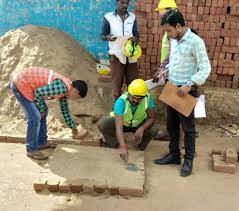
GS11. minimize wastages
GS12. revert to superior for selection/sorting of materials
GS13. identify location at which violation of any safety norms may lead to accidents
Handle and use hand and power tools related to masonry work
Description
This unit describes the skills and knowledge required to handle and use hand and power tools related to
masonry work
Scope
The scope covers the following :
Handle & use hand and power tools related to masonry work
Elements and Performance Criteria
Handle & use hand and power tools related to masonry work
To be competent, the user/individual on the job must be able to:
PC1. identify basic tools used for masonry works such as hand tools, measuring tools, power tools
etc.
PC2. check for serviceability/safety of tools and report faults to superiors
PC3. select and use appropriate hand and power tools relevant to the task
PC4. set up and use basic leveling devices like spirit level ,water level & straight edge
PC5. transfer levels and carry out set out using appropriate tools
PC6. maintain tools and equipment’s
PC7. clean and maintain tools prior to and after use
Knowledge and Understanding (KU)
The individual on the job needs to know and understand:
KU1. standard practices of masonry works
KU2. safety rules and regulation for handling and storing required masonry tools,
KU3. personal protection including the use of related safety gears & equipment
KU4. how to request tools and materials as per set procedures
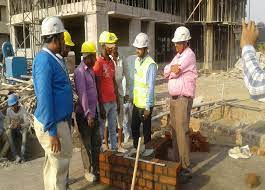
KU5. maintenance of tools and equipment
KU6. different type of masonry tools and their maintenance and care
KU7. use of different masonry tool and material
KU8. basic leveling devices ,their setting and use
KU9. transferring levels using basic leveling devices
KU10. different power tools and equipment’s used in masonry
KU11. functions and uses of different tools and equipment’s
Generic Skills (GS)
User/individual on the job needs to know how to:
GS1. write in at least one language, preferably in the local language of the site
GS2. read in at least one language, preferably the local language of the site
GS3. read instructions, guidelines, sign boards, safety rules and safety tags
GS4. read instructions and exit routes during emergency
GS5. speak in one or more languages, preferably in one of the local languages of the site
GS6. listen and follow instructions communicated by supervisors
GS7. orally and efficiently communicate with team member
GS8. decide whether the workplace is safe for working and also the relevant work is not creating
hazardous conditions for others
GS9. plan self-work as per the direction /close supervision of a level-2 mason and above
GS10. ensure work is done within time and as per desired quality as per instructions provided by
superiors
GS11. identify location at which violation of any safety norms may lead to accident
Assist in tiling, stone laying and concrete masonry works
Description
This unit describes the skills and knowledge required to assist in tiling, stone laying and concrete masonry
works
Scope
The scope covers the following :
Assist in tiling and stone laying works
Assist in concreting works
Mix and apply Anti-Termite solution on soil as per instructions
Carry out brick soling and PCC flooring
Elements and Performance Criteria
Assist in tiling and stone laying works
To be competent, the user/individual on the job must be able to:
PC1. identify the correct tools and materials required for relevant task
PC2. ensure transfer, handling and overall storage of tile, marble, granite and stone as per the
requirement
PC3. ensure proper stacking of tiles, marble, granite and stones of required numbers as per
requirement of work
PC4. check and ensure the surface in free of dust, dirt ,debris & check for evenness of surface and
fill voids to compact and even surface prior to commencement of work
PC5. ensure removal all loose concrete laitance and roughening of the surface prior to laying of
tiles and stones
PC6. clean the tiles / stones prior to fixing to remove damaged and dirty tiles/stones
PC7. ensure proper pre-wetting of tiles ,stones and base surface prior to commencement of work
PC8. check and measure the basic dimensions of the room / floor / walls like slope, right angle &
surface plane under supervision
PC9. check for basic characteristics of the tiles and stones like color, shade, size & batch number
under supervision
PC10. assist the superior to cut tiles / stones as per the design specifications using appropriate
tools

PC11. ensure fine aggregate is sieved as per requirement/instruction
PC12. ensure proper mixing of cement and mortar in the required quantity for relevant work
PC13. assist in leveling, marking dummy dots & spreading mortar using trowel to the required
thickness as per instruction
PC14. assist in arranging tiles as per the design plan and put spacers between tiles as per
requirement
PC15. assist in filling of joints by preparing and applying appropriate grout and sealant
PC16. protect the area of tiling / stone laying from damage after during and after completion of
work
PC17. ensure curing of the tiled surface for specified time
Assist in concreting works
To be competent, the user/individual on the job must be able to:
PC18. clean and remove all debris from the area prior to pouring of concrete
PC19. identify the correct type of tools and materials for concreting works
PC20. sieve the fine aggregate as per requirement/instruction in case of manual mixing of concrete
PC21. perform manual concrete batching and mixing as per instruction to prepare mix of
appropriate ratio
PC22. pour concrete mix into the forms and casts under close supervision
PC23. assist in passing the correct tools as per the requirement
PC24. ensure proper mixing of cement and mortar in the required quantity for relevant work
PC25. assist in pouring of concrete in forms/moulds as per instruction
PC26. carry out proper compaction of concrete using appropriate vibrators
PC27. assist in leveling and finishing of concrete as per instruction using appropriate tools
PC28. carry out curing of finished surface as per instruction
PC29. protect the concreted area from damage during and after work
Mix and apply Anti-Termite solution on soil as per instructions
To be competent, the user/individual on the job must be able to:
PC30. mix anti-termite solution with water in defined proportions as per instructions of site
engineer
PC31. make holes of appropriate depth in the soil with the help of steel rods as per instructions of
site engineer
PC32. Use appropriate PPEs and sprinkle the anti-termite mix on the soil as per instructions of site
engineer
Carry out brick soling and PCC flooring
To be competent, the user/individual on the job must be able to:
PC33. carry out leveling and compaction of back filling as per requirement
PC34. carry out soaking of bricks prior to laying
PC35. lay bricks course over the compacted fill
PC36. fill gap in bricks with sand / suitable filling material
PC37. check the level of finished surface
PC38. fix baton strips on the floors for making panels as per requirement
PC39. carry out the screening of PCC over the brick soling in specified panels
PC40. carry out leveling and finishing of the finished surface
PC41. carry out curing of the finished floor
Knowledge and Understanding (KU)
The individual on the job needs to know and understand:
KU1. standard practices of masonry works
KU2. safety rules and regulation for handling and storing required masonry tools, equipment and
materials
KU3. personal protection including the use of related safety gears & equipment
KU4. to request tools and materials as per set procedures
KU5. maintenance of tools and equipment
KU6. basics sketches of the area / surface on which tiles and stones are to be laid
KU7. basic principles of measurement
KU8. standard sizes of all masonry tiling and concreting tools along with the their care and
maintenance
KU9. how to select and use basic tools and tackles for tiling / stone laying and concreting such as
measuring tape/rule, hammers, rubber/wooden hammers mallets, spades, bolster chisel,
wedges, power wet saws, tile scribes or hand held tile cutters, screeds, floats, shovels, rakes
,vibrators etc
KU10. various techniques / procedures for cutting different types of tiles and stones to size and as
per design requirements
KU11. types of tiles, their physical properties & applications as per use
KU12. basic methods and techniques of preparing bed mortar, cement slurry and
KU13. basic techniques for surface preparation for various surfaces
KU14. importance of hacking of RCC surfaces
KU15. tile / stone laying as per the specifications within the tolerance levels required at the site
under supervision
KU16. basic properties of concrete including weight, slump, etc
KU17. how to assess if concrete has been mixed as per the appropriate ratio for site requirements
KU18. how to perform batching and mixing of materials for concreting
KU19. how to screed the concrete to correct levels
KU20. appropriate technique for pouring of concrete in the form of layers as per the requirements
for the construction site
KU21. how to ensure proper curing as per the instruction
KU22. set out levels and marking floor thickness relevant to task
KU23. different type of PCC flooring works
KU24. different baton strips and their uses
KU25. process of brick soling and PCC flooring
Generic Skills (GS)
User/individual on the job needs to know how to:
GS1. write in at least one language, preferably in the local language of the site
GS2. read in at least one language, preferably the local language of the site
GS3. instructions, guidelines, sign boards, safety rules and safety tags
GS4. instructions and exit routes during emergency
GS5. speak in one or more language, preferably in one of the local languages of the site
GS6. listen and follow instructions communicated by supervisors
GS7. communicate orally and effectively with team member
GS8. decide whether the workplace is safe for working and also the relevant work is not creating
hazardous conditions for others
GS9. plan self-work as per the direction under close supervision of a superior
GS10. ensure work is done within time and as per desired quality as per instructions provided by
superiors
GS11. identify location at which violation of any safety norms may lead to accident
Assist in brick/block work including fixing doors and windows and plastering work
Description
This unit describes the skills and knowledge required to assist in brick/block work including fixing doors
and windows and plastering work

Scope
The scope covers the following :
Assist in brick/block work
Assist in plastering work
Fix door & window frames in room/cubical
Elements and Performance Criteria
Assist in brick/block work
To be competent, the user/individual on the job must be able to:
PC1. identify the correct type of tools and materials required for relevant task
PC2. ensure proper transfer, handling and overall storage of correct material asper the
requirement of relevant works
PC3. ensure proper stacking of bricks / blocks of required numbers as per requirement at the work
place
PC4. check and ensure the base surface in free of dust, dirt& debris prior to commencement of
work
PC5. ensure removal all loose concrete laitance and roughening of the surface prior to laying of
brick/block
PC6. ensure soaking of brick/block and pre wetting of base surface prior to commencement of work
PC7. ensure fine aggregate is sieved as per requirement/instruction
PC8. ensure proper mixing of cement and mortar in the required quantity for relevant work
PC9. assist in setting out the layouts as per the instruction
PC10. assist in passing the correct tools as per the requirement
PC11. assist in spreading mortar using trowel to the required thickness as per instructions
PC12. build brick walls using English bond
PC13. build brick walls using Flemish bond
PC14. remove excess mortar from face of wall keeping surface clean
PC15. carry out /ensure curing of finished surface as per instructions
PC16. protect the constructed area from damage during and after work
Assist in plastering work
To be competent, the user/individual on the job must be able to:
PC17. check and measure the basic dimensions of the room / floor / walls likes lope, right angle &
surface plane under supervision
PC18. check for evenness of surface and fill voids to compact and even surface
PC19. remove all loose concrete laitance and assist in roughening the surface
PC20. carry out pre-wetting of the base surface prior to plastering
PC21. ensure proper mixing of cement mortar and cement slurry in the required quantity and
proportion
PC22. transfer levels to required thickness of plastering , mark dummy dots & apply cement slurry
on surface to be plastered
PC23. carry out curing of finished surface as per instructions
PC24. protect the constructed area from damage during and after work
Fix door & window frames in room/cubical
To be competent, the user/individual on the job must be able to:
PC25. mark, set out location of door and window to be fixed
PC26. check and carry out proper alignment of the frame
PC27. anchor the frame to the walls using appropriate bolting/grouting
PC28. check the holdfast position and grout it between bricks / blocks of wall
PC29. anchor window frames in frames / openings in the wall using nails and secure the
frame(usually aluminum frames)
PC30. fill the gap between wall and door frame with non shrink material/grout
PC31. assist in fixing standard sections for wooden/metal windows, doors and ventilator frames
Knowledge and Understanding (KU)
The individual on the job needs to know and understand:
KU1. standard practices of masonry works
KU2. safety rules and regulation for handling and storing required masonry tools, equipment and
materials
KU3. personal protection including the use of related safety gears & equipment
KU4. to request tools and materials as per set procedures
KU5. maintenance of tools and equipment
KU6. basics of masonry, plastering, tiling ,concreting and stone installation works
KU7. different type of masonry tools and their maintenance and care
KU8. to use the basic masonry tools and equipment’s such as measurement tape ,trowel, mortar
pan, hammer, bolster chisel, spade, rubber/wooden hammers, mallets, wedges, jointers,
square, plumb bob, straight edge spirit level, water level tube, line thread, sponge, volume
box, weighing balance, tile scribes or hand held tile cutters, screeds, floats ,power wet saws
,electric drills, anglers and grinders, vibrators ,wheel barrow & hand operated concrete mixer
KU9. basic leveling devices like plum bob, spirit level, water level ,their setting and use
KU10. transferring levels using basic leveling devices
KU11. various techniques / procedures for cutting different types of bricks to required sizes
KU12. how to assist to lay and fix brick / blocks in position with alignment under supervision
KU13. knowledge of different bonds in brickwork
KU14. importance of different mix of mortar required for brick/block and plastering works
KU15. basic techniques for surface preparation for plastering works
KU16. importance of hacking of RCC surfaces
KU17. marking of dummy dots for transfer of levels
KU18. standard size of door / window, type of materials and fittings used
KU19. how to align the frames and checking the holdfast position
KU20. how to anchor frames to walls and fill gap between wall and frames
Generic Skills (GS)
User/individual on the job needs to know how to:
GS1. write in at least one language, preferably in the local language of the site
GS2. read in at least one language, preferably the local language of the site
GS3. read instructions, guidelines, sign boards, safety rules and safety tags
GS4. read instructions and exit routes during emergency
GS5. speak in one or more language, preferably in one of the local languages of the site
GS6. listen and follow instructions communicated by supervisors
GS7. communicate orally and effectively with team member
GS8. decide whether the workplace is safe for working and also the relevant work is not creating
hazardous conditions for others
GS9. plan self-work as per the direction under close supervision of a superior
GS10. ensure work is done within time and as per desired quality as per instructions provided by
superiors
GS11. identify location at which violation of any safety norms may lead to accident



